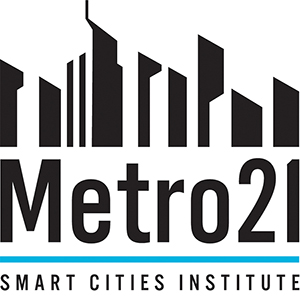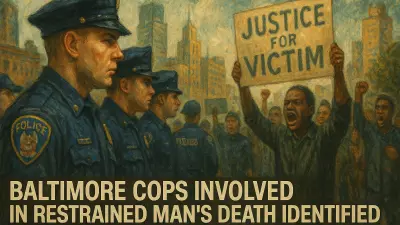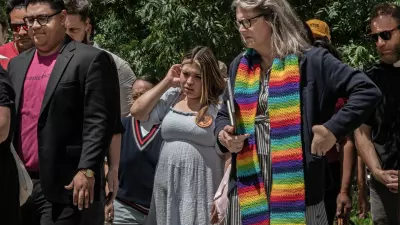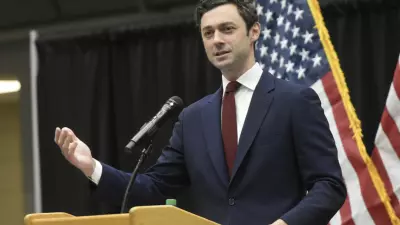The term “smart cities” has evolved considerably over the last few years.

Initially, most considered smart cities technology as tools that could be used to help optimize municipal operations to improve citizen quality of life.
The COVID-19 pandemic, the murder of George Floyd, and the Jan. 6, 2001, attack on the U.S. Capitol (and all that led up to it) were tipping points for how we understand and interact with tracking technologies like sensors, cameras, and smartphones. There is a lot of confusion, fear, and distrust of technological advancements, especially if they are being used in the public, such as on streets and in parks.
 At Carnegie Mellon University’s Metro21: Smart Cities Institute, we use technology as a tool, joining forces with civic and community partners to guide, implement, and inform innovation to improve quality of life through access to infrastructure, affordable transportation, economic opportunity, and more.
At Carnegie Mellon University’s Metro21: Smart Cities Institute, we use technology as a tool, joining forces with civic and community partners to guide, implement, and inform innovation to improve quality of life through access to infrastructure, affordable transportation, economic opportunity, and more.

We work with municipal and equity partners to solve problems like landslides and light pollution. We also collaborate with partners and funders to address things like traffic signalization to improve traffic flow, reduce time at red lights and reduce CO2 emissions — as seen in the Surtrac intelligent traffic signaling system, which spun into RapidFlow Technologies and was recently acquired by Miovision.
During the early months of the pandemic, Metro21 partnered with Surtrac’s inventor to use its underlying artificial intelligence to optimize delivery routes to provide meals to more than 100,000 families in need throughout Penn Hills, McKeesport, and McKees Rocks.
What the past three years have taught me is that while the underlying technology is important, the priority is the people that technology impacts, the policies that govern its use, and, most importantly, earning and maintaining trust.
It’s about listening to communities, with community needs in the lead. It’s about working with trusted community partners to design, implement, and evaluate a product or a service that helps them improve their daily lives. I used to think that municipalities (elected officials and their staff) had the best perspective of community needs — as they were elected into office by the people — and, by default, policies and city budgets reflect community needs. When in fact, municipalities don’t necessarily have their finger on the pulse of the needs of their constituents, and those who show up for meetings at City Hall or in community centers don’t always represent the community. We can do better.
Right now, the federal, state, and local funding and policies are not set up to enable community-focused smart cities technology deployments. Currently, in cities like Pittsburgh (and the majority of other U.S. cities lauded as examples of smart cities), it’s akin to a potluck — a mishmash of different projects and initiatives, some in pilot stage, some with stalled out projects and so many ideas and proposals.
“Metro21 takes the 21st century technology research and developed at CMU and deploys it with our municipal and equity partners to solve real-world problems.” — Karen Lightman, Executive Director, Metro21
Tools like ShotSpotter are used by the police departments around the country to understand and address gun-related crime, but not without its concerns related to underlying bias (as ShotSpotter is typically located in underserved communities).
There’s a lot of distrust of technology (and those who use it) in communities nationwide. We have a lot of work to do to build back that trust. It is complicated, and systemic changes are needed to rebuild trust in our communities. We must equitably and inclusively improve quality of life (for everyone) through the smart use of tech.
Now, and moving forward in the coming year, our country’s communities will have access to once-in-a-generation funding (i.e. hundreds of millions, if not billions) for projects that are ripe for the inclusion of deployment of smart cities technology that is equitable, inclusive, sustainable, and accessible. This allows for tremendous opportunity to change the current state of smart cities deployment.
Some may want to propose laws to ban all smart cities technology due to fear of all things tech (including AI). Others might hope for the best and that the strongest proposals will include smart cities tech that is relevant and impactful.
What is really needed is seemingly simple things like gaining the trust of communities through engagement with them now, in anticipation of this funding — put those communities in the lead — hear what their real-world problems are and create policies and funding to support communities being in the design, deployment, and evaluation of smart cities technology.







